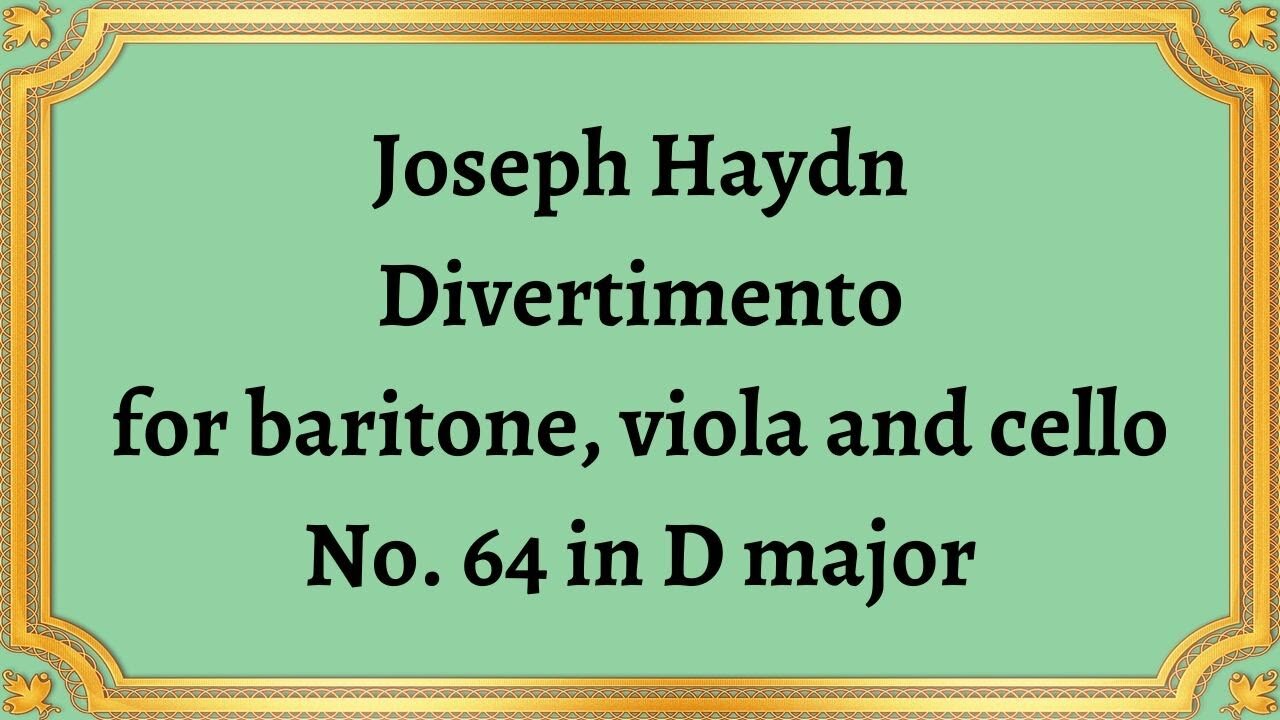Premium Only Content

Joseph Haydn Divertimento for baritone, viola and cello No. 64 in D major
#JosephHaydn #Divertimento #Baritone #Viola #Cello #Dmajor #chambermusic #Adagio #Menuetto #Allegro #classicalmusic #baryton #instrumentation #musiccomposition #ChamberMusicRepertoire
Joseph Haydn, one of the most renowned classical composers, wrote more than 100 divertimentos. The Divertimento for Baritone, Viola, and Cello No. 64 in D major stands out as a unique composition in the chamber music repertoire. It features a rare instrument, the baryton, which Haydn often used to create unique and complex melodies.
The Divertimento for Baritone, Viola, and Cello No. 64 in D major was composed in 1773 upon the request of Prince Nikolaus Esterhazy for his baryton-playing ensemble. The work's instrumentation includes baritone, viola, and cello. Unlike most of his compositions, Haydn used the unusual tuning of the baryton to create a rich tonal palette. The baryton has a set of wire strings on the back of the fingerboard, which when plucked by the left hand produce a unique sound that adds to the piece's texture.
The first movement of the Divertimento is marked as Adagio, which means slowly. The opening melody is played by the viola, interweaving with the cello and baritone in the background. The soaring, and at times, melancholic melody, creates an appreciable ambience. The second movement, marked as Menuetto, is in a 3/4 meter, with a more rhythmic and upbeat feel. As the name suggests, this movement presents a pleasant dance-like style. The trio section of the Menuetto is scored for the baritone and viola in a duet with the cello providing an accompaniment. The final movement, marked as Allegro, is the most technically demanding section of the Divertimento, with the baryton and viola carrying the melody, and the cello providing a rich harmonic foundation. Haydn's use of the baryton in this work is exceptional, as it produces a sound that is not found in any other chamber music composition.
Joseph Haydn's Divertimento for Baritone, Viola, and Cello No. 64 in D major is a significant contribution to the chamber music literature. The composer's ability to create a rich texture using a rarely heard instrument such as the baryton is evident in this composition. Haydn's music has endured centuries, and it's exciting to listen to how he blends the tones from different instruments, creating works that continue to enthrall audiences today.
You have the opportunity to support the channel https://destream.net/live/RadSiarAl/donate
-
 52:11
52:11
Classical music_Music Inspiration
1 month agoAlexandra Glazunov Excerpts from the ballet "Raymonda"
1041 -
 6:52
6:52
ThinkStory
16 hours agoThe INSANE Pennywise Daughter Theory - IT: Welcome to Derry
10K -
 7:49
7:49
Blackstone Griddles
13 hours agoEasy Weeknight Meals: Southwest Patty Melt
15.7K -
 52:51
52:51
A Cigar Hustlers Podcast Every Day
23 hours agoEpisode 2 Hustler Every Day
11.3K -
 LIVE
LIVE
FyrBorne
2 hours ago🔴Battlefield 6 Live M&K Gameplay: Assault Might Actually Be OP In REDSEC
95 watching -
 36:10
36:10
ZeeeMedia
16 hours agoCash Quickly Becoming ILLEGAL & Silicon Valley's Devilish Endeavors | Daily Pulse Ep 140
62.5K40 -
 LIVE
LIVE
PudgeTV
2 hours ago🟣 Arc Raiders - Gaming on Rumble | Toxic Tuesday Tantrums
85 watching -
 LIVE
LIVE
BBQPenguin_
4 hours agoBATTLEFIELD 6: UPDATE NOT WORKING ON PS5?!🤯 NEW Update (1.1.1.5) - First Impressions!
31 watching -
 22:38
22:38
Standpoint with Gabe Groisman
20 hours agoFrom Democrat to Conservative. Florida Rep Hillary Cassel Explains
26.3K5 -
 1:56:49
1:56:49
MG Show
21 hours agoDemocrat Shutdown Filibuster Ends; Brennan, Strzok and Page Subpoenaed
28.2K9